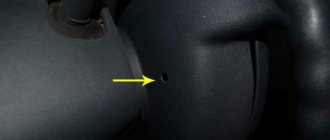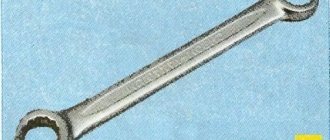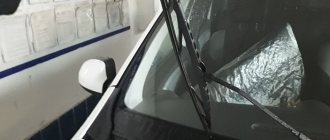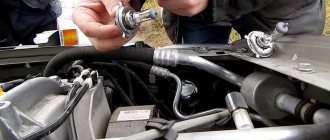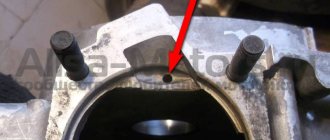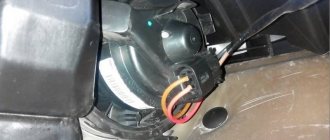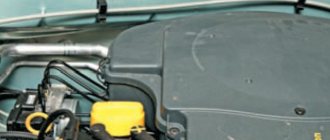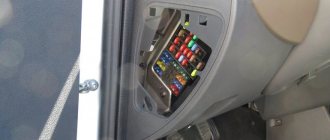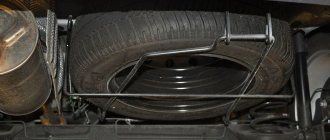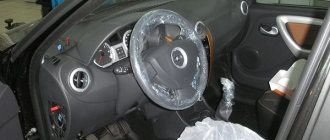Largus 5th gear ratios are excellent for those who drive the car mainly around the city, often with a full load. The shortcomings are revealed on the highway when you don’t have time to reach 100 km/h, and the engine speed is already at around 3000 rpm. You can get rid of the hum and howl of the engine and gearbox with the help of a simple modification: “replacing the fifth gear gear.”
Lada Largus
Over time, you get used to the shortcomings of the car you drive all the time. But there are exceptions to the rules. For two years now I have been using the Lada-Largus editorial station wagon and still cannot accept the heart-rending roar of its engine on country roads. On a long journey, you get tired of this tedious monologue, and the rising tachometer needle puts pressure not only on the psyche: you constantly think about increased fuel consumption. Judging by the numerous unflattering comments on thematic Internet forums, I’m not the only one who doesn’t like the too short fifth gear. Moreover, this problem mainly concerns the most popular passenger version with a 16-valve 1.6-liter K4M engine. Different boxes and main pairs are installed on Largus (see table). And in a passenger car with a sixteen-valve engine, fifth gear turns out to be the most high-torque. Even the van speeds faster in fifth gear. Although logically it should be the other way around.
About the disadvantages of gears
During a thorough and repeated analysis carried out by service centers, as well as based on numerous reviews from owners, it was established that such a malfunction is typical for the LADA Largus modification, which is equipped with a popular 1.6-liter engine (“K4M”) with a 16-valve head design . It is in this version of the engine tandem with the gearbox that the same gear can cause discomfort to the owner, which is why the 5th gear gear is replaced. The manufacturer is also familiar with this shortcoming, which subsequently manifested itself in its desire to use different combinations of not only engines with gearboxes, but also different options for the main pairs in transmissions (see table).
An interesting fact is that the cargo version of the LADA Largus, the so-called “van,” in fifth gear is capable of achieving a higher maximum speed in comparison with its passenger counterpart. The manufacturer intended everything just the opposite.
The noise emitted by the 5th stage gear not only annoyingly penetrated into the cabin, but also caused increased fuel consumption due to the presence of increased friction in the corresponding gearbox unit. That is why many owners of the model replace the fifth gear.
WHAT IS GOOD?
The standard sixteen-valve box has both pros and cons. Among the advantages is the ability to provide dynamic acceleration and excellent elasticity. A car with a gross weight of nearly two tons and armed with only a 105-horsepower engine confidently stays in traffic, and in fifth gear it cheerfully picks up from 50 km/h - there is no need to shift often. On long hauls, sometimes you drive for several hours in fifth as if on automatic. It’s convenient, but you have to pay for it with increased noise and fuel consumption - and even when the speedometer needle has not even reached a hundred. Therefore, together with the specialists from our technical center, we decided to experiment with different gear ratios. After all, the design of the Largus transmission allows you to change fifth gear gears without disassembling the entire box or even removing the unit from the car. By the way, owners of Renault models (for example, Logan or Sandero), as well as Nissan-Almera, can similarly configure the top gear for themselves.
Work progress
The work is carried out in the following order:
- The first step is to remove the engine crankcase protection. It is secured with six bolts, for which a 10mm wrench is used.
- If the gear is replaced without using a special lift, then the car must be jacked up from the front left wheel, and then some stable objects must be placed under the body in case the jack “collapses” and Largus falls. After this, the left front wheel and the right front fender liner are removed. After this, the gearbox oil is drained. To do this, use a size 8 wrench to loosen the drain plug and remove it, then drain the oil.
- After this, the left front shield that protects from dirt is removed, as well as the bolts that secure the power steering pipeline to the support and directly to it.
- The next step is to remove the connecting rod from the left suspension subframe. To do this, loosen the nut and remove the bolt, then with a sharp movement, unscrew the rod.
- The next step is to remove the light wiring from the engine crankcase. To do this, you need to disconnect the high beam connector and remove the wiring from the rear cover of the gearbox housing. It is under it that the fifth gear gear is located.
- After the wiring is removed, you need to remove the rear crankcase cover, which requires unscrewing the bolts.
- The cover should be removed carefully, since during removal there is a possibility of damaging the small plastic groove through which gearbox oil is supplied to the gears.
- In addition, you need to remember how much the fifth gear mounting pin protrudes; during assembly, it must be installed in the same way. This is important not only for Largus cars.
- It must be driven into the fifth gear shift fork using a hammer and a punch.
- The next step is to block the primary and secondary shafts. To do this, use the gearshift lever to engage first gear. After that, use the fifth gear fork to activate it. This procedure makes it easier to remove the input shaft nut and secondary shaft bolt. They are tightened tightly, so you will need a good wrench. After removing them, the input shaft nut is removed. This can be done with a screwdriver.
- The next step is to remove the secondary shaft bolt. This is best done using a TORX head.
- After removing the primary shaft nut and secondary shaft bolt, the fifth gear fork is removed. Then the synchronizer gear hub is removed. This is best done using a puller. It is worth noting that categorical care is needed here, since there is a possibility of damage to the gear itself.
- Then, no less carefully, the remaining parts are removed. This can be done without the help of tools. It is important to remember their location for subsequent assembly of the unit.
- For the next step, the secondary shaft bolt must be screwed back a few turns. He will have to play the role of support for the puller.
- The puller itself must be installed so that on one side it rests on the shaft bolt, while its legs go under the gear teeth. If the puller is installed correctly, removing it will not cause any problems. During the process, it will only be necessary to unscrew the bolt by one and a half turns of thread, since during extraction the gear will rest against it.
- After the fifth gear gear is removed, you need to inspect all parts for faults, as they may need to be replaced.
- Assembly is carried out in reverse order. First, you should clean the entire gearbox structure from dirt, both outside and inside. It is necessary to clean the splines of the gears and shafts with which they will fit, and then apply a fixing compound to them.
- The gear is seated and tapped using a rubber mallet. In this case, the blows must be applied along the axis of the shaft, so that it does not warp.
- The synchronizer clutch should be oriented towards the gearbox housing - the sharp ends of its teeth should be turned in this direction.
- Before installing the fork, you must engage fifth gear using the lever. After this, to ensure the alignment of the holes, the lever is switched to neutral mode, and the holes themselves are centered using a screwdriver.
- Then the fifth gear pin is inserted. As stated, it should perform the same as before disassembly. After this, the rear crankcase cover is put on, the wiring is returned to it, which is connected to the rear light switch connector. The connecting rod returns to its place, and its fastenings are tightened. After this, the power steering line, front mudguard, right front fender liner, front wheel and crankcase protection are returned to their place.
After completing the assembly process, you need to fill the gearbox oil, and the Largus car will be ready for use.
Source: ladaautos.ru
03–05
Fuel consumption on the Lada-Largus test route with different fifth gears.
Gear ratio: 0.892 (1); 0.820 (2); 0.795 (3). Fuel consumption on the Lada-Largus test route with different fifth gears. Gear ratio: 0.892 (1); 0.820 (2); 0.795 (3).
There are different sets of gears on sale, each of which will cost about 3,000 rubles. The craftsman will charge the same amount for a replacement. The beauty is that you won’t have to part with the car for a long time: a competent repairman can handle it in a couple of hours. Let's try!
THREE FROM THE CASTER
Editorial "Largus" tried on three pairs of gears with different gear ratios. In addition to the standard fifth gear of 0.892, we sequentially installed sets of 0.820 and 0.795 (see table). On a 300-kilometer test route, including highways and suburban roads, they compared the difference in fuel consumption and accumulated subjective assessments, which are sometimes even more interesting for the car owner than measurement data. For reliability, the expert assessment was supported by measurements at the Dmitrovsky test site. Test results and comments are presented below, including photographs, tables and diagrams.
0,892. The basic version provides excellent elasticity. Fifth gear can be used from 50 km/h even when fully loaded. You rarely have to shift down - the traction reserve is enough even for quick overtaking. But the noise of the engine operating at high speeds is annoying, even if you are moving no faster than the permitted 90 km/h: on long trips you quickly get tired.
Summary. The basic version is good for those who move mainly around the city, often with a full load
t-03
0,820. The engine is no longer perceived as so elastic, but still within normal limits. You only have to shift to fourth gear for quick accelerations. Even with a full load and in fifth gear, the car easily overcomes climbs, and on horizontal sections it confidently picks up speed from 60 km/h. At the same time, it became significantly quieter at high speeds. The gain on fuel is insignificant.
Summary . A universal option for every day. Fifth gear is quite functional in the city, and driving on the highway has become more comfortable. We recommend that AVTOVAZ take this option as the base one.
0.795. My personal choice . Editorial "Largus" is rarely fully loaded, and on country routes I usually drive on roads with flat terrain. The number of shifts from fifth to fourth on the test route increased, but only slightly. When upshifting, I stayed in fourth gear a little longer before engaging fifth, and when overtaking, on the contrary, I began to shift from fifth to fourth more often.
Summary. Optimal for suburban highways, tolerable for trips around the city. If you load your car to capacity or drive on roads with long, steep climbs or frequent overtaking, choose the 0.82 option.
0.756 and 0.738 . We have not tested these options, but judging by our impressions of the 0.795 fifth gear box, they accumulate the shortcomings of the previous option. Elasticity will deteriorate, you will have to shift from fifth to fourth more often, and there will be a significant gap between these gears.
Summary . These options are convenient, for example, for driving on a flat and empty highway at a constant speed and rarely overtaking.
"LADA-LARGUS": CHANGING THE FIFTH GEAR GEARS
We hang the car on a lift or on stands and remove the left front wheel.
1. Dismantle the plastic mudguard, carefully freeing it from the pistons and latches.
2. Unscrew the upper bolt of the subframe bracket, loosen the lower one and move the bracket to the side so that it does not interfere.
3. Unscrew the fastening of the power steering pipeline to the gearbox and remove the connector from the reverse switch.
4. Unscrew the drain plug, drain the oil and screw the plug back. Unscrew the three bolts of the rear gearbox cover...
5….and carefully remove it so as not to damage the lubrication groove. Use a rod to knock out the pin that secures the fifth gear fork.
6. Move the fork towards you and engage first gear with the lever: the primary and secondary shafts are blocked - this makes it easier to unscrew the gears. Unscrew the input shaft nut...
7….remove the synchronizer fork and clutch, the driven gear and the fifth gear synchronizer hub. It is more convenient to use a two-jaw puller with thin legs.
8. Having unscrewed the bolt of the secondary shaft, remove the drive gear.
9. Change the gears and assemble in reverse order. A few notes about the assembly. We recommend applying a few drops of a fixative (for example, Frenetanche) to the splines of the drive gear. We tighten the nut of the primary shaft to a torque of 190 Nm, and the bolt on the secondary shaft to 80 Nm. Don't forget to fill the box with oil, preferably fresh.
And most importantly. We changed the gears ourselves, fortunately we were not opening the first box and we also have the appropriate tool. If you don't have enough experience or courage to replace it yourself, leave the job to professionals.
Reliability jr5
It’s difficult to praise the mechanical JR5 in any way, but there’s nothing particularly to reproach either. The unit itself is structurally simple, often hums, and the clarity of gear shifting leaves much to be desired. Over time, it requires overhaul or, in severe cases, replacement due to the destruction of key mechanisms. Often, car owners have to disassemble the box because the 5th speed refuses to turn off.
A roller bearing with a plastic cage on the secondary shaft is another weak point of the JR5 mechanics. The separator often falls apart even at short mileage, which leads to balls clumping together. At a minimum, the manual transmission starts to hum, but there have been cases when balls got caught between the gears. The deficiency was eliminated after the JR5 modernization.
Many problems can be avoided if you follow the manual transmission maintenance regulations and use original oil. It is advisable to change the working material of the box every 50-60 thousand kilometers. TranselfTRJ 75W-80 is suitable for replacement. After passing 10-15 thousand km, it is necessary to take control measurements of the fluid. In general, the box is old, moderately reliable, but not perfect. With the right approach it will last a long time and can be repaired without problems.
